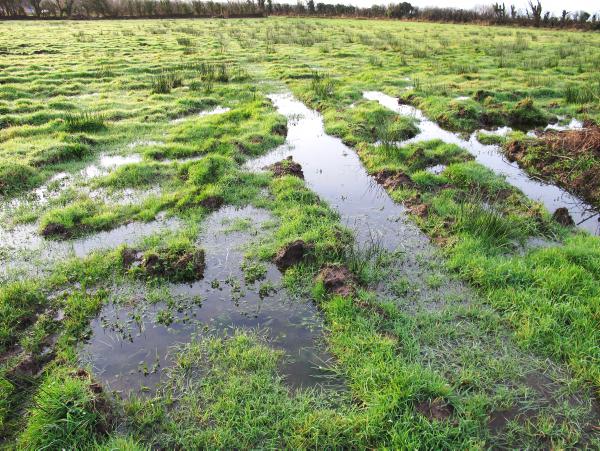Land type is a major limiting factor in the level of production and farming activity that can be carried out. Wet, heavy soils can prevent grazing early and late in the year, which reduces the amount of cheap liveweight gain from grass.
During periods of heavy rainfall, ground conditions can quickly become unsuitable for livestock and machinery.
As such, rehousing in summer can be a common experience and, as ground is less capable of carrying machinery for silage making, harvesting date can be delayed due to late fertilizer applications and delayed cutting.
Mike Dillane farms 59ha of grassland near Lixnaw, Co Kerry. Land type is mixed but is generally heavy clay and peat soils, which become difficult to manage during wet periods.
After two extremely wet summers in 2011 and 2012, one block of 28 acres had become completely waterlogged as shown in Picture 1.

During 2012, the land produced just one cut of silage for the entire year. Feed value was 52DMD, which is similar to straw.
The silage was meant to be harvested as first cut in early summer, but harvesting was delayed until September. In 2011, there was one cut of silage and one grazing achieved.
Not being able to utilise the land block was causing a problem for Mike to follow the farm plan produced for his business.
With plenty of advice and support from his programme adviser Alan Dillon, and local adviser Oliver McGrath, Mike decided to undertake a major drainage programme.
Drainage
Work on draining the land commenced on 1 March 2013 with local drainage contractors Carroll Brothers taking on the project.
As the farm is in a low lying coastal region, there was a fall of less than 4ft from the soil surface to the perimeter drains.
Also, due to the coastal location, the land lies along a tidal river, which can cause drains to back up.
Drains were excavated every 15m and, due to the lack of natural fall, they were laser-sighted.
The drainage channels were dug 3ft deep, piped and then stoned to the surface (Picture 2).

There are 100 sumps across the drains that are excavated to 6ft deep. They are 2ft long and 9in wide and filled with stone.
These act as outlets for groundwater as there is insufficient outflow to the river for deep drainage systems.
Once the drains were installed, Mike then mole-ploughed the ground at right angles to the land drains. This will help ground water to move into the stone drain channels.
As the subsoil consists of the blue clay, it is ideal for holding the mole drains as they are less likely to collapse.
Mole drains work best in soils with high clay content, whereas, in soils with a high silt content, the mole drains are more inclined to collapse if soils are saturated.
Reseeding
The drainage work was completed by 10 June and was delayed due to spells of unsuitable weather.
The entire land block was then ploughed, harrowed and land levelled. Mike also installed a new roadway on the land to make it easier to access land with machinery and livestock.
Grass seed was drilled at 15kg/acre and the grass seed mix is outlined in Table 1.

The ground was fertilized with three bags per acre of 10:10:20 and topped up with CAN.
Silage was cut on 10 August and yielded nine bales per acre.
The land was then grazed with 40 autumn-born yearling cattle weighing 450kg to 500kg liveweight (until 10 November).
The land block was re-fenced with mains electric and is set up for paddocks with 11 drinking troughs now installed where there were previously only three.
Cost
The total cost of the project was €64,850, or €2,316 per acre. This includes the land drainage, fencing and reseeding.
The cost breakdown of the project is outlined in Table 2.

Digger work totalled €28,000, with draining stone costing €22,350. Draining pipe cost €3,500. Fencing cost €5,000 and tilling work cost €6,000.
The project was expensive but it was a remarkable success. Despite January and February being excessively wet, Mike managed to get cows out onto the land on 22 March.
A total of 30 cows and calves are now grazing the ground after getting a half bag of urea a week earlier.
The cost is being depreciated over 15 years, which is an annual cost of €4,323 or €154 per acre over the same period.
However, land is the biggest asset that any farm has and, given a land value of €10,000 per acre, to not utilise it would have devalued this ground.
Mike has increased from 70 cows to 90 cows in the past two years and these animals have to be grazed.
Renting the same 28 acres for grazing and silage harvesting at €200 per acre would have an annual cost of €5,600 and, as there is no land security with land rental, there is less chance of reseeding or improving rented ground.
Land drainage is a long-term investment, but, if carried out properly, it is a worthwhile one.
Adviser comment
“It is visible from the results of the work carried out what can be achieved on wet land with the correct drainage procedures and reseeding programme.” – Alan Dillon.






 This is a subscriber-only article
This is a subscriber-only article



















SHARING OPTIONS: